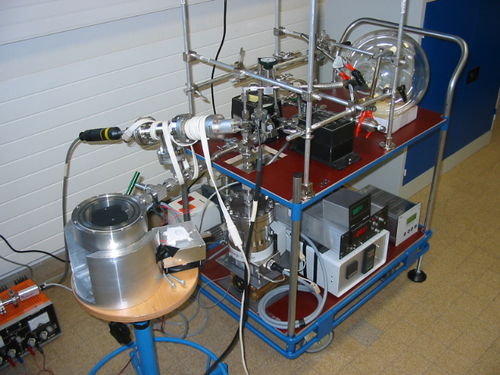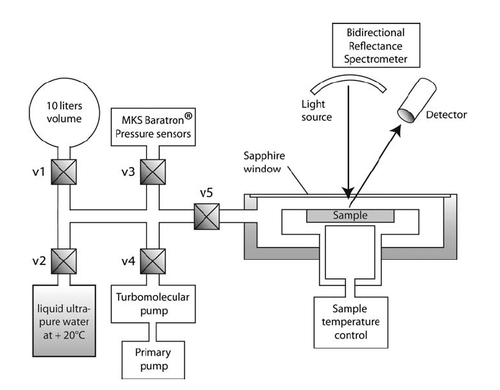SERAC simulation chamber
Description
An environmental simulation chamber ‘SERAC’ for adsorption measurements down to -40°C was designed as a complement to the SHINE reflectance spectro-gonio radiometer.
References: Pommerol 2009(PhD thesis), Pommerol et al. 2009


Sample holder
The empty volume inside the chamber is 181 mL. Sample holder can have different sizes and sample thickness can vary between 1 mm and 10 mm.

Optics
The simulation chamber is closed on its upper surface by a sapphire window 150 mm in diameter and 3 mm thick. Multiple reflections between the sample and the window can be corrected with our calibration routine.
Temperature control
The sample holder is cooled by a double stage Peltier elements. It can reach -30°C to -50°C depending on the external temperature (room T, or cold room down to -20°C). Temperature of the sample is adjusted and controlled using a heating resistance, a Peltier cooling system and a PT100 Platinum resistance thermometer placed directly under the bottom of the sample. A PID controller is used to program the sample temperature (fixed, ramp, cycles. . .).
Vacuum
A turbo molecular pump is used to quickly pump the entire system to pressures lower than 10-6 mbar. As a number of experiments requires an excellent static vacuum the whole system was optimized to avoid leaks and outgassing. After consequent outgassing at high temperature and secondary vacuum, it is possible to obtain a high quality static vacuum (<10-6 mbar) that can be maintained in a close system at least for a few weeks.
Pressure sensors
A high accuracy MKS Baratron absolute pressure sensor (range: 1 Torr) monitors pressure inside the chamber between 10-6 and 1 mbar. Relative uncertainty on the recorded value is highly dependant on pressure range: 50% at 10-5 mbar, 5% at 10-4 mbar, 0.5% at 10-3 mbar, 0.1% at 10-2 mbar and less than 0.1% at higher pressure.
Sample dehydration procedure
Prior to measurements the sample, sample holder and walls of the simulation chamber can be dehydrated by maintaining them at high temperature (70–170°C) under secondary vacuum during several hours to evacuate water and other trapped gases.
procedure exemple
The sample holder filled with a mineral powder is placed in the simulation chamber. The dehydration process is divided into successive steps that aim to remove the maximum amount of moisture from the sample while avoiding deterioration of its surface (volume change and dehydration cracking).
– First, the sample is heated at 170°C following a temperature ramp of 1 h while the chamber is still open to air.
– After 1 h of heating at 170°C, the chamber is closed and heating stops. Sample temperature decreases for a few hours to reach the temperature of the cold room (0 to -20°C).
– Then, the simulation chamber is slowly pumped down to pressure lower than 10-6 mbar.
– Under secondary vacuum, the sample is heated again at 170°C during a minimum of 10 h. In the same time, the chamber itself and fittings are heated using heating cords to ensure a quick and efficient outgassing.
– Finally, the sample is cooled to the temperature at which measurements are performed and temperature is then kept constant (±0.1°C) for the complete set of measurements.
Characteristics
– Sample volume:
– D = 8 cm, h = 6 cm: up to 312 cm3
– minimum temperature: – 40°C (a room T°)
– maximum temperature: +80°C
– stabilisation time to -40°C: 15min
– vacuum: < 1 10-6 mb
Sample holders (aluminum):
– rectangular, L= 80 mm, l=35 mm, h=10 mm
– rectangular, L= 80 mm, l=35 mm, h=6 mm
– rectangular, L= 80 mm, l=35 mm, h=3 mm



